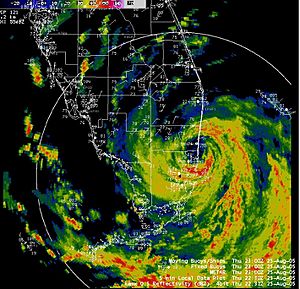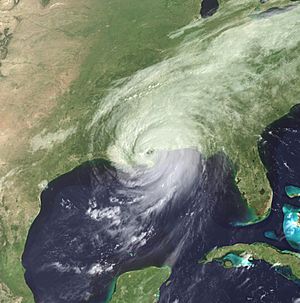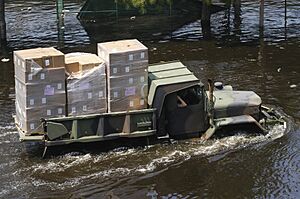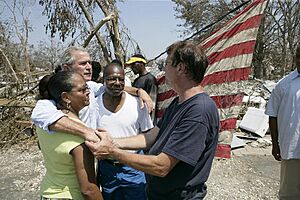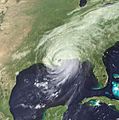Timeline of Hurricane Katrina facts for kids
| Hurricane Katrina |
|
 |
|
|
General Other wikis |
|
This article shares a timeline of Hurricane Katrina, a powerful storm that hit the United States in August 2005. It covers how the hurricane formed, its journey, and the important events that happened afterward.
Contents
- How Hurricane Katrina Formed
- Katrina's Journey Through the Gulf of Mexico
- Katrina's Landfalls and Immediate Impact
- The Aftermath of Hurricane Katrina
- Tuesday, August 30, 2005: Widespread Flooding and Evacuation
- Wednesday, August 31, 2005: Katrina Weakens, City Underwater
- Thursday, September 1, 2005: Aid Efforts and Challenges
- Friday, September 2, 2005: Continued Rescue Efforts
- Saturday, September 3, 2005: More Troops Deployed
- Sunday, September 4, 2005: Superdome Evacuation Complete
- Monday, September 5, 2005: Levee Breach Closed
- Tuesday, September 6, 2005: Forced Evacuations
- Wednesday, September 7, 2005: Troops Continue to Help
- Thursday, September 8, 2005: Labor Law Suspended
- Friday, September 9, 2005: Leadership Change
- Saturday, September 10, 2005: Peak Deployment
- Sunday, September 11, 2005: Environmental Concerns and Rescues
- Monday, September 12, 2005: FEMA Director Resigns
- Wednesday, September 14, 2005: Tax Relief Approved
- Thursday, September 15, 2005: Bush Addresses the Nation
- Monday, September 19, 2005: Another Evacuation Order
- Wednesday, September 21, 2005: Death Toll Rises
- Friday, September 23, 2005: Hurricane Rita Approaches
- Saturday, September 24, 2005: Rita Makes Landfall
- Saturday, October 1, 2005: Death Toll Continues to Rise
- Tuesday, October 4, 2005: Final Death Toll Update
- Wednesday, October 5, 2005: New Orleans Layoffs
- Images for kids
How Hurricane Katrina Formed
Tuesday, August 23, 2005: A Storm Begins
What became Hurricane Katrina started as Tropical Depression Twelve. This small storm formed over the Bahamas. It was partly made from the leftover parts of an earlier storm. As conditions improved, this new storm began to grow stronger.
Wednesday, August 24, 2005: Tropical Storm Katrina
Tropical Depression Twelve gained strength and became Tropical Storm Katrina. This meant it had stronger winds and was becoming a more serious weather event.
Thursday, August 25, 2005: Katrina Hits Florida
Katrina grew into a Category 1 hurricane. Just two hours later, it made landfall in Florida near Fort Lauderdale. Its winds reached 85 miles per hour (137 km/h). The eye of the hurricane even passed over the National Hurricane Center office. Katrina spent about six hours moving over the Everglades. It weakened back to a tropical storm before reaching the Gulf of Mexico.
Katrina's Journey Through the Gulf of Mexico
Friday, August 26, 2005: Growing Stronger Over Water
Early in the morning, Katrina was downgraded to a tropical storm. But it quickly gained strength again over the warm waters of the Gulf of Mexico. It became a Category 1 hurricane once more.
Later that day, the National Hurricane Center changed its prediction for Katrina's path. It now looked like the storm would hit the Mississippi/Alabama coast. Louisiana's Governor, Kathleen Blanco, declared a state of emergency. This allowed the state to prepare for the storm and get help from the federal government. Federal troops were sent to Louisiana to help plan for the emergency.
By late afternoon, Katrina had become a Category 2 storm.
Saturday, August 27, 2005: Mandatory Evacuations Begin
By morning, Hurricane Katrina had become a Category 3 storm. This meant it was a major hurricane.
Officials in several Louisiana parishes (like counties) ordered everyone to leave. These included St. Charles, St. Tammany, and Plaquemines Parishes. Jefferson and St. Bernard Parishes also asked people to leave, especially those in low-lying areas. Tolls were removed from bridges to help people evacuate faster.
New Orleans Mayor Ray Nagin announced a voluntary evacuation for his city. He said the city's Superdome would open as a "shelter of last resort." People going there were told to bring their own food and drinks. The Louisiana National Guard brought water and food to the Superdome for 15,000 people.
Governor Blanco asked President George W. Bush for federal financial help. President Bush declared a federal state of emergency for Louisiana. This allowed federal assistance and funding to be used for relief efforts. More National Guard troops were sent to help.
That night, hurricane experts briefed President Bush, Governor Blanco, and Mayor Nagin about Katrina's status.
Sunday, August 28, 2005: A Category 5 Monster
Just after midnight, Hurricane Katrina became a Category 4 storm. By 7:00 AM CDT, it had reached Category 5 intensity. Its winds were 175 miles per hour (282 km/h), with gusts up to 190 miles per hour (306 km/h). This made it an extremely dangerous storm.
Mayor Nagin then ordered a mandatory evacuation for all of New Orleans. He said they were facing the storm most people had feared. Governor Blanco confirmed that President Bush had asked her to ensure a mandatory evacuation. The National Weather Service warned of "devastating" damage.
The Louisiana Superdome opened as a shelter for those who couldn't leave. About 20,000 people went there. More National Guard troops were deployed. President Bush also declared states of emergency for Alabama and Mississippi.
Katrina's Landfalls and Immediate Impact
Monday, August 29, 2005: Hitting the Coast
At 6:10 AM CDT, Hurricane Katrina made its second landfall near Buras, Louisiana. It was a strong Category 3 hurricane with winds over 125 miles per hour (205 km/h). Katrina then moved north, crossing Lake Borgne. It made its final landfall near the Pearl River on the Louisiana/Mississippi border. It was still a Category 3 storm with 120 miles per hour (193 km/h) winds.
By 8:00 AM CDT, water was rising in New Orleans along the Industrial Canal. The National Weather Service issued a flash flood warning. They reported a levee breach at the Industrial Canal and warned people to move to higher ground. By 9:00 AM CDT, the Lower Ninth Ward had 6–8 feet (1.8–2.4 m) of water.
At 10:00 AM CDT, Katrina made its third landfall near Pearlington, Mississippi, and Slidell, Louisiana. Many towns along the Mississippi coast were severely damaged. President Bush spoke about the storm, thanking governors for preparing.
By 11:00 AM CDT, St. Bernard Parish had about 10 feet (3 m) of water. Many rooftops were completely submerged.
In the afternoon, New Orleans officials confirmed a breach in the 17th Street Canal levee. Other canals also had breaches. New Orleans Homeland Security Director Terry Ebbertt confirmed there were casualties. He said police were assessing damage and rescuing people. The hardest-hit areas included the Lower Ninth Ward and New Orleans East.
Governor Blanco ordered school buses to evacuate survivors in New Orleans. More National Guard troops were deployed. FEMA Director Michael Brown asked fire and rescue departments outside the affected states not to send help without a specific request. President Bush declared a major disaster for Louisiana, Mississippi, and Alabama.
The Aftermath of Hurricane Katrina
Tuesday, August 30, 2005: Widespread Flooding and Evacuation
By noon, Homeland Security Secretary Michael Chertoff realized the New Orleans levee breaches could not be stopped. Governor Blanco ordered everyone in New Orleans, including those at the Superdome, to evacuate. She used her powers to get hundreds of buses. These buses eventually evacuated over 15,000 people to the Superdome by September 1. There were also reports of looting. Governor Blanco asked President Bush to send federal troops to help restore order. More National Guard troops were deployed. US Coast Guard (USCG) helicopters rescued 350 people from rooftops.
Wednesday, August 31, 2005: Katrina Weakens, City Underwater
Hurricane Katrina was downgraded to a tropical depression. By 10:00 PM CDT, Mayor Nagin announced that efforts to fix the 17th Street Canal levee breach had failed. At this point, 85% of New Orleans was underwater.
Secretary Chertoff created the "White House Task Force on Hurricane Katrina Response." He also declared Katrina an "Incident of National Significance." The USS Bataan and other Navy ships were sent to help with relief efforts. More National Guard troops were deployed.
President Bush returned early from his vacation. He flew low over the Gulf Coast to see the damage. He later declared a Public Health Emergency for the region. Mayor Nagin ordered police to focus on controlling looting and set a curfew. Work began to close the 17th Street Canal breach. The remnants of Katrina caused heavy rain and road damage in Canada.
Railroad companies worked to restore service. BNSF Railway expected to have limited freight service by September 1. Norfolk Southern also got most of its main lines working again. USCG helicopters rescued 1,259 more people, bringing the total to 1,609.
Thursday, September 1, 2005: Aid Efforts and Challenges
The U.S. Senate passed a relief package. President Bush appeared on "Good Morning America." He said he understood the frustration of victims waiting for aid. He emphasized that saving lives was the top priority. A Canadian search-and-rescue team arrived in New Orleans to help.
National Guardsmen and buses began arriving at the Superdome. The American Red Cross wanted to set up a shelter, but was asked to wait due to ongoing military rescue operations. Conditions at the Superdome and the Ernest N. Morial Convention Center worsened. Food and water were scarce. Secretary Chertoff and FEMA Director Brown faced criticism for not knowing about the crisis at the Convention Center sooner.
Secretary Chertoff announced that 4,200 military police would be sent to New Orleans. Governor Blanco asked for 40,000 more National Guard troops. California rescue crews saved hundreds of people. The sealing of the 17th Street Canal from Lake Pontchartrain began.
The New Orleans suburb of Gretna blocked the Crescent City Connection bridge, turning back fleeing flood victims. This caused controversy. The Kansas City Southern Railway reopened its line between Meridian, Mississippi, and Shreveport, Louisiana.
President Bush signed a $10.5 billion relief package. He toured the damaged Gulf Coast and authorized using oil from the Strategic Petroleum Reserve. The Bush administration asked Governor Blanco to request a federal takeover of the New Orleans evacuation. Louisiana officials rejected this, concerned it would be like martial law.
The 17th Street Canal was blocked, stopping water flow into the city. BNSF Railway pledged $1 million and offered rail transportation for relief efforts. USCG helicopters rescued 2,859 more people, bringing the total to 4,468.
Friday, September 2, 2005: Continued Rescue Efforts
President Bush signed the $10.5 billion relief package. He toured the Gulf Coast and ordered more active duty forces to the region. He also allowed oil to be released from the Strategic Petroleum Reserve. Over 21,000 National Guard troops were deployed. USCG helicopters rescued over 6,500 people from rooftops and 2,500 by boat.
Saturday, September 3, 2005: More Troops Deployed
Over 28,500 National Guard troops were deployed. Coast Guard air operations continued to save lives.
Sunday, September 4, 2005: Superdome Evacuation Complete
The evacuation of the Superdome was finished. Over 34,000 National Guard troops were deployed. USCG helicopters rescued 1,037 people from rooftops. USCG units also helped evacuate over 9,400 patients and staff from hospitals.
Monday, September 5, 2005: Levee Breach Closed
The 17th Street Canal levee breach was finally closed with rock and sandbags. The canal was then used to pump water out of the city. Over 40,000 National Guard troops were deployed. USCG operations rescued over 17,940 people in the New Orleans area.
Tuesday, September 6, 2005: Forced Evacuations
Rescue workers found many people still in New Orleans who had not left. They were worried about their property, pets, or shelter conditions. Due to unsanitary conditions and E. coli bacteria in the floodwaters, Mayor Nagin ordered everyone not involved in cleanup to be forcibly evacuated. Over 43,800 National Guard troops were deployed. Some politicians criticized the handling of the disaster. USCG operations rescued 10,182 people.
Wednesday, September 7, 2005: Troops Continue to Help
Over 45,600 National Guard troops were deployed.
Thursday, September 8, 2005: Labor Law Suspended
President Bush suspended the Davis-Bacon Act. This allowed federal contractors rebuilding after Katrina to pay workers less than the usual wages. This decision upset labor leaders. Over 46,400 National Guard troops were deployed. USCG operations rescued 342 people.
Friday, September 9, 2005: Leadership Change
FEMA Director Michael Brown was removed from leading the Hurricane Katrina relief efforts. Vice Admiral Thad W. Allen of the US Coast Guard replaced him. A "zero access" policy for media was announced regarding body recovery, but this was later changed after a lawsuit. Over 46,500 National Guard troops were deployed. USCG operations rescued 162 people.
Saturday, September 10, 2005: Peak Deployment
The federal government agreed not to restrict media coverage. Over 46,800 National Guard troops were deployed, which was the peak number.
Sunday, September 11, 2005: Environmental Concerns and Rescues
Louisiana's Department of Environmental Quality asked railroads for information about damaged train cars. They were concerned about hazardous materials. Illinois police officers helped rescue hundreds of frozen embryos from a New Orleans hospital.
Monday, September 12, 2005: FEMA Director Resigns
Michael Brown resigned as Director of FEMA.
Wednesday, September 14, 2005: Tax Relief Approved
Congress approved the Katrina Emergency Tax Relief Act of 2005. This law helped Hurricane Katrina victims with things like retirement account withdrawals and debt forgiveness.
Thursday, September 15, 2005: Bush Addresses the Nation
President Bush spoke to the nation from Jackson Square in New Orleans. He outlined the federal government's steps to help victims.
Monday, September 19, 2005: Another Evacuation Order
Mayor Nagin ordered another evacuation of New Orleans due to Hurricane Rita approaching. The levees and pumps were still weak from Katrina.
Wednesday, September 21, 2005: Death Toll Rises
The official death toll from Hurricane Katrina was raised to 1,036. This was the first time since 1928 that a natural disaster in the U.S. had officially killed at least 1,000 people.
Friday, September 23, 2005: Hurricane Rita Approaches
Hurricane Rita headed towards Houston, bringing rain to New Orleans. Efforts continued to strengthen the levees.
Saturday, September 24, 2005: Rita Makes Landfall
Hurricane Rita made landfall just west of where Katrina had hit. This made the problems even worse. The official regionwide death toll from Hurricane Katrina was updated to 1,080.
Saturday, October 1, 2005: Death Toll Continues to Rise
The official death toll from Hurricane Katrina was updated to 1,135.
Tuesday, October 4, 2005: Final Death Toll Update
By this date, about 1.5 million people had been evacuated. Over 1 million applied for federal aid. The official death toll was updated to 1,836, with over 2,500 people still missing.
Wednesday, October 5, 2005: New Orleans Layoffs
Mayor Nagin announced that New Orleans would lay off 3,000 city employees due to lack of funds. This was about half of the city's workforce.
Images for kids


